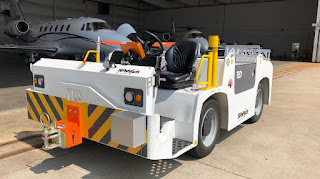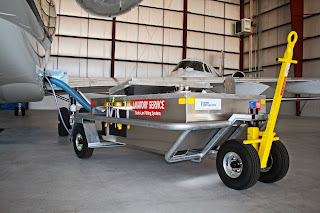The Importance of Ramp Safety and How to Improve It
An argument could be made that an airside work environment, perhaps
particularly the ramp, is like an incubator for accident risk. Airports
are high-activity, high-stress workplaces, in which huge monetary losses
that accrue during ground-time means working as quickly as possible is a
must. On top of which, ground crews are driving dozens of specialized
motorized vehicles, often hauling volatile chemicals to service massive
aircraft, sometimes doing so in inclement weather.
The briefest lapse in concentration, miscommunication, equipment failure, or operator-oversight in an aircraft tow tractor or baggage tug can (and does) result in costly and dangerous accidents. One of those accidents can cost hundreds of thousands of dollars in damage to vehicles and aircraft, sometimes even more costly ground-time for the airline, a lot of angry passengers, and worst of all, critical injury or worse for the crew members involved. Costly and dangerous as these accidents are, however, there are steps that can be taken to, at the very least, mitigate the risks of ramp damage.
Causes and Costs of Ramp Accidents
First off, these are not rare or unlikely events. According to the data, there are about 27,000 ramp accidents a year. Around 243,000 people are injured each year in those accidents, with an injury rate of 9 per 1,000 departures. Along with the vast toll taken by those injury rates, those ramp accidents, directly and indirectly, cost at least $10 billion a year. Needless to say, that’s a massive problem with an enormous cost both monetarily and to the health and safety of ground crews.
The causes of ramp accidents are largely the same as the causes of accidents in other situations. They can be the result of operators of aircraft tugs and other ground support equipment (GSE) simply becoming distracted. However, a problem that seems to be a more widespread issue is either a lack of training or a lack of training on a specific GSE. Additional risks include inclement weather, communication shortcomings, and an absence of technological accommodation in the GSE.
Preventing Ramp Accidents
Of course, the causes of the accidents suggest solutions for them. An emphasis needs to be placed on how vital operating GSE without unnecessary distractions is. There should be no music on headphones while working and no use of unauthorized electronic devices or unnecessary interaction with other crew members. That, however, can be included as part of a broader strategy that puts a premium on training. Airside work environments can be stressful and there’s certainly an emphasis on working quickly, which can make cutting corners on training tempting.
However, no crew member should use any GSE without proper training on that specific equipment. And it should be noted that being certified or proficient with one kind of equipment doesn’t automatically translate as proficiency with another piece of GSE. Training should also incorporate best practices for better communication and coordination among the members of a ground crew.
Finally, there are a number of equipment upgrades that can make an airside work environment safer. Those include deploying telematics programs, weather-specific modifications for GSE, and operator safety-enhancing tools like AERO Specialties’ SiPsHitch™ aircraft towing system.
About AERO Specialties
AERO Specialties has established an international reputation as one of the most innovative thought leaders in the industry. They are committed to producing and providing the best-quality GSE on the market, by consistently remaining on the cutting edge of airside technological advancement. That dedication to superior GSE is also shared by AERO Specialties’ team members. They insist that everyone on the staff—from sales to support—are given detailed, in-depth training on GSE including the duties of airside ground crews and their equipment. From an aircraft ground power unit to decals, AERO Specialties has what you need to keep your aviation business flying high.
Find out how your aviation business can really takeoff with AERO Specialties’ GSE equipment and training, at Aerospecialties.com
The briefest lapse in concentration, miscommunication, equipment failure, or operator-oversight in an aircraft tow tractor or baggage tug can (and does) result in costly and dangerous accidents. One of those accidents can cost hundreds of thousands of dollars in damage to vehicles and aircraft, sometimes even more costly ground-time for the airline, a lot of angry passengers, and worst of all, critical injury or worse for the crew members involved. Costly and dangerous as these accidents are, however, there are steps that can be taken to, at the very least, mitigate the risks of ramp damage.
Causes and Costs of Ramp Accidents
First off, these are not rare or unlikely events. According to the data, there are about 27,000 ramp accidents a year. Around 243,000 people are injured each year in those accidents, with an injury rate of 9 per 1,000 departures. Along with the vast toll taken by those injury rates, those ramp accidents, directly and indirectly, cost at least $10 billion a year. Needless to say, that’s a massive problem with an enormous cost both monetarily and to the health and safety of ground crews.
The causes of ramp accidents are largely the same as the causes of accidents in other situations. They can be the result of operators of aircraft tugs and other ground support equipment (GSE) simply becoming distracted. However, a problem that seems to be a more widespread issue is either a lack of training or a lack of training on a specific GSE. Additional risks include inclement weather, communication shortcomings, and an absence of technological accommodation in the GSE.
Preventing Ramp Accidents
Of course, the causes of the accidents suggest solutions for them. An emphasis needs to be placed on how vital operating GSE without unnecessary distractions is. There should be no music on headphones while working and no use of unauthorized electronic devices or unnecessary interaction with other crew members. That, however, can be included as part of a broader strategy that puts a premium on training. Airside work environments can be stressful and there’s certainly an emphasis on working quickly, which can make cutting corners on training tempting.
However, no crew member should use any GSE without proper training on that specific equipment. And it should be noted that being certified or proficient with one kind of equipment doesn’t automatically translate as proficiency with another piece of GSE. Training should also incorporate best practices for better communication and coordination among the members of a ground crew.
Finally, there are a number of equipment upgrades that can make an airside work environment safer. Those include deploying telematics programs, weather-specific modifications for GSE, and operator safety-enhancing tools like AERO Specialties’ SiPsHitch™ aircraft towing system.
About AERO Specialties
AERO Specialties has established an international reputation as one of the most innovative thought leaders in the industry. They are committed to producing and providing the best-quality GSE on the market, by consistently remaining on the cutting edge of airside technological advancement. That dedication to superior GSE is also shared by AERO Specialties’ team members. They insist that everyone on the staff—from sales to support—are given detailed, in-depth training on GSE including the duties of airside ground crews and their equipment. From an aircraft ground power unit to decals, AERO Specialties has what you need to keep your aviation business flying high.
Find out how your aviation business can really takeoff with AERO Specialties’ GSE equipment and training, at Aerospecialties.com




Comments
Post a Comment